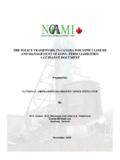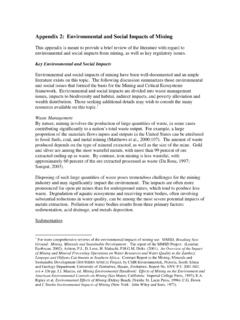Transcription of Revenue trends and tax proposals - National Treasury
1 45 4 Revenue trends and tax proposals In brief Over two decades South Africa has built a progressive tax system founded on the principles of equity, efficiency, simplicity, transparency and certainty. Tax revenues have remained buoyant in 2013/14, and the Revenue estimate presented in last year s budget has been revised upwards by R1 billion to R899 billion. Tax proposals for 2014/15 include personal income tax relief of billion; steps to encourage enterprise development and household savings; measures to address acid mine drainage; and design adjustments to the proposed carbon tax. The first report of the Tax Review Committee, which examines how the tax system affects small and medium enterprises, will soon be published for public comment. Overview outh Africa s tax system forms part of the foundation of the country s public finances. The balance between the three major taxes personal income tax, value-added tax (VAT) and corporate income tax provides the basis for a tax system that responds flexibly and sustainably to the business cycle.
2 While nominal total tax Revenue declined from per cent of GDP in 2007/08 to per cent in 2009/10 as a result of the 2009 recession, tax Revenue is expected to recover to per cent of GDP in 2013/14, supported by strong growth in corporate income tax and customs duties. Nominal total tax revenues are estimated to grow at an average of per cent per year over the medium term, reaching per cent of GDP in 2016/17. The tax policy framework has proven resilient in a period of global volatility, and compares favourably with international standards. Buoyant tax Revenue collections, however, depend on improved tax compliance and strong economic growth, as outlined in the NDP. S South Africa s tax system responds flexibly and sustainably to the business cycle 2014 BUDGET REVIEW 46 Two decades of building a progressive and fair tax system Over 20 years of democracy, government has built a tax system based on the principles of: Equity.
3 All residents should contribute to the fiscus in proportion to their ability to do so. Efficiency. Taxes should be raised in a way that interferes minimally with economic decision-making. Simplicity. To the degree possible, taxes should be easy to understand, and should be collected in a timely and convenient manner. Transparency and certainty. The way taxes are calculated and collected should be certain, supported by transparent rules and procedures. The tax system raises Revenue to deliver public services without placing too high a burden on businesses and individuals. Reforms have aimed to establish stable Revenue streams, maintain a more equitable distribution of National resources, encourage investment and savings, and address market failures. These reforms have balanced the imperatives of equity and international competitiveness. Total tax Revenue , which amounted to billion in 1994/95, grew to billion in 2012/13. Over this period, nominal tax Revenue grew sevenfold at a compound annual growth rate of per cent, while nominal GDP grew at per cent.
4 As a percentage of GDP, total tax Revenue has increased from 22 per cent in the 1980s to an average of 25 per cent in the democratic era. Revenue from corporate and personal income tax, and VAT, account for about 80 per cent of total tax Revenue . Nominal tax Revenue collections, 1994/95 2012/13R millionCAGR1R millionCAGR1R millionCAGR1R millionCAGR11994/9544 973 13 591 29 288 113 775 1999/0085 884 20 972 48 377 201 266 2004/05110 982 70 782 98 158 354 979 2008/09195 146 165 539 154 343 625 100 2012/13275 822 159 259 023 813 826 1. Compound annual growth rate (percentage)Individuals CompaniesValue-added tax Total tax Revenue From 1994 to 1999, Revenue growth was largely supported by personal income tax, which constituted 41 per cent of total tax Revenue by 1999/00.
5 Corporate income tax Revenue grew strongly between 2000/01 and 2008/09 in line with robust economic growth, the commodity boom and improved compliance. During this period, government introduced efforts to expand the tax base known as base broadening including capital gains tax and measures to limit tax avoidance, reinforced by South African Revenue Service (SARS) administrative reforms to improve compliance. These measures allowed for a reduction in the headline corporate income tax rate from 40 to 28 per cent. Additional tax measures were introduced to enhance the competitive position of businesses and the economy, including incentives to support industrial policy, skills development, urban development zones, and research and development. The top marginal personal income tax rate was reduced from 45 to 40 per cent, and personal income tax brackets and thresholds were increased to provide relief from inflation.
6 The progressive nature of the personal income tax system ensures that those with higher incomes pay a larger share. The system s fairness is undermined if individuals are able to structure their income to avoid income tax, and amendments to tax legislation over time have sought to curtail this possibility. The tax system plays an important role in addressing market failures, as governments around the world look for a more effective combination of interventions (both regulations and taxes) to deal with challenges related to solid waste, water pollution, local air pollution and climate change. Tax proposals Tax proposals for the 2014 Budget continue to prioritise economic growth, job creation and generating sufficient Revenue to finance government spending in line with the National Development Plan (NDP) objectives of expanding the economy and reducing unemployment. The main tax proposals include: Personal income tax relief of billion Measures to encourage small enterprise development Clarity on valuation of company cars for fringe-benefit tax purposes Reforms to the tax treatment of the risk business of long-term insurers Personal income tax relief of billion CHAPTER 4: Revenue trends AND TAX proposals 47 Amending the rules for VAT input tax to combat gold smuggling Increases in fuel and excise taxes Measures to address acid mine drainage Adjustment of the proposed carbon tax and its alignment with desired emission-reduction outcomes to be identified by the Department of Environmental Affairs.
7 Tax-free savings accounts will be implemented, creating a mechanism to increase household savings and support financial inclusion. The employment tax incentive, introduced at the beginning of 2014, will help unemployed youth gain skills and experience in the workplace. Direct taxes: individuals Personal income tax relief To compensate for the effects of inflation, which pushes some individuals into higher tax brackets and reduces their purchasing power, the personal income tax brackets and rebates will be adjusted, providing individuals with billion in personal income tax relief. Table provides an overview of the adjusted brackets for 2014/15. Table Personal income tax rate and bracket adjustments, 2013/14 2014/152013/142014/15 Taxable income (R) Rates of tax Taxable income (R) Rates of taxR0 - R165 60018% of each R1R0 - R174 55018% of each R1R165 601 - R258 750R29 808 + 25% of the amountR174 551 - R272 700R31 419 + 25% of the amountabove R165 600above R174 550R258 751 - R358 110R53 096 + 30% of the amountR272 701 - R377 450R55 957 + 30% of the amountabove R258 750above R272 700R358 111 - R500 940R82 904 + 35% of the amountR377 451 - R528 000R87 382 + 35% of the amountabove R358 110above R377 450R500 941 - R638 600R132 894 + 38% of the amountR528 001 - R673 100R140 074 + 38% of the amountabove R500 940above R528 000R638 601R185 205 + 40% of the amountR673 101R195 212 + 40% of the amountabove R638 600above R673 100 RebatesRebatesPrimary R12 080 Primary R12 726 Secondary R6 750 Secondary R7 110 TertiaryR2 250 TertiaryR2 367 Tax thresholdTax thresholdBelow age 65R67 111 Below age 65R70 700 Age 65 and overR104 611 Age 65 and overR110 200 Age 75 and overR117 111 Age 75 and overR123 350 Table shows how much tax is expected to be
8 Paid by individuals at different levels of taxable income for 2014/15. About 69 per cent of taxpayers have taxable incomes below R250 000 per year, accounting for about 36 per cent of all taxable income and contributing just under 17 per cent of personal income tax. This group will receive 39 per cent of the total amount of tax relief that arises from the increase in the rebates and income tax brackets. The top per cent (about 154 000) of the estimated million individual taxpayers will account for per cent of personal income tax. Individuals in this bracket have taxable income greater than R1 million per year. Employment tax incentive to help unemployed youth gain skills and experience Brackets and rebates adjusted to compensate for effects of inflation About 69 per cent of taxpayers account for 36 per cent of all taxable income 2014 BUDGET REVIEW 48 Table Estimates of individual taxpayers and taxable income.
9 2014/15 Taxable bracket Number%R million% R million%R million%R million%0 - R70 00018 835 791 194 445 25 25 R70 001 - R150 0002 758 078 288 161 18 092 1 740 16 351 001 - R250 0001 644 142 321 624 41 491 1 843 39 648 001 - R350 000 852 656 250 125 43 789 1 557 42 232 001 - R500 000 531 173 220 166 48 072 1 475 46 597 001 - R750 000 346 123 208 636 55 303 1 335 53 969 001 - R1 000 000 132 917 114 037 34 663 591 34 072 000 001 + 154 111 291 160 103 760 685 103 075 419 200 693 908 345 169 9 225 335 944 total15 254 991 1 888 353 345 194 9 250 335 944 individuals with taxable income below the income tax thresholdIncome tax payable after reliefRegistered individualsTaxable incomeIncome tax payable before reliefPersonal income tax relief Medical tax credits Monthly medical scheme contribution tax credits will be increased from R242 to R257 per month for the first two beneficiaries, and from R162 to R172 per month for each additional beneficiary, with effect from 1 March 2014.
10 Tax-preferred savings accounts Tax-preferred savings accounts, first mooted in the 2012 Budget Review as a measure to encourage household savings, will proceed. As previously announced, these accounts will have an initial annual contribution limit of R30 000, to be increased regularly in line with inflation, and a lifetime contribution limit of R500 000. The account will allow investments in bank deposits, collective investment schemes, exchange-traded funds and retail savings bonds. Eligible service providers will include banks, asset managers, life insurers and brokerages. Retirement savings reforms Reforms over the past two years have aimed to encourage more people to save for retirement and to preserve their savings throughout their working lives. A document that briefly describes the changes up to this point and sets out anticipated future reforms will soon be released. The proposals below support the broader package of retirement reforms, and are intended to make the system simpler and fairer.













